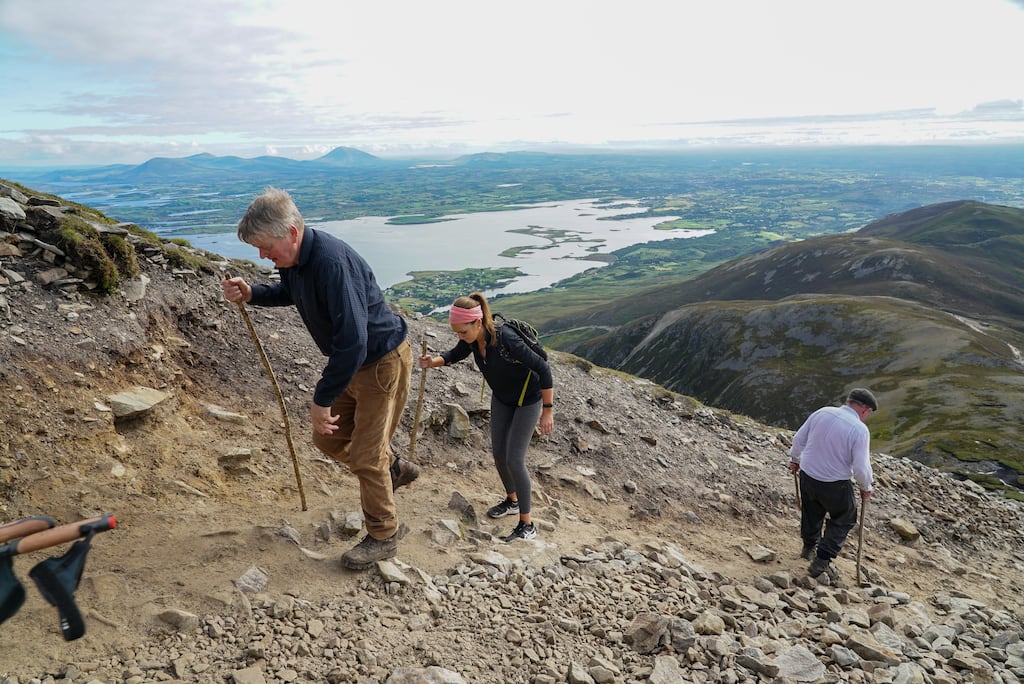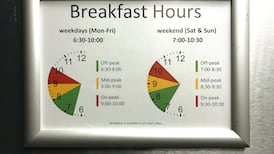We have our own Irish version of the permissive society. It’s not about sex – it’s about land.
On the last Sunday of this month, perhaps 25,000 people will climb to the top of Croagh Patrick in Co Mayo. This is probably the oldest continuous mass gathering in Ireland: before the day was called Reek Sunday and associated with the patron saint, it was known as Crom Dubh Sunday, after a pre-Christian god.
There’s some deep pulse beneath the skin of this ritual. It sustains ideas of communal belonging and connection to the natural world that matter, in our time of existential crisis, more than ever. But here’s a strange fact: neither pilgrims nor any one other visitor has any right to walk that punishing path up to the summit of Croagh Patrick. In principle, the climb could be stopped and the path blocked.
This seems hard to credit. Not only does this tradition have deep roots in Irish prehistory but the path itself has just been restored with funding of €480,000 from the Department of Rural and Community Development and support from Mayo County Council.
READ MORE
Uggool Beach is public but the landowners charge for access to it. The public authorities have failed to uphold the right of citizens to visit what should be one of Ireland’s most spectacular outdoor amenities
Yet, the path – and the mountain – are private property. As with almost every other off-road pathway in Ireland, access is, in legal terms, “permissive”. Permission is granted by the landowners, which means that it could be retracted.
The Office of the Planning Regulator defines the situation with admirable clarity: “Permissive access agreements do not constitute a dedication of a right of way over the property and the landowner retains a right to withdraw this permission.”
I’m not suggesting for a moment that this is going to happen at Croagh Patrick. That would raise Hell and probably result in the reinfestation of the island with poisonous snakes. But the possibility that it could happen highlights an increasingly absurd contradiction between public access and private ownership that the State has failed – perhaps one should say refused – to resolve.
This tension is not theoretical. The climb to the summit of Croagh Patrick starts at Murrisk. Pilgrims gathering there will notice that most of the shoreline is fenced off with Private Property and No Trespassers signs warning them to keep out.
That shoreline path leads to the stunningly beautiful Uggool Beach, widely regarded as among the finest in Ireland, to which access was denied by the erection of fencing by the landowners in 1989. In 2013, the then Ombudsman Emily O’Reilly told the Oireachtas that this created the “one of the most intractable issues we ever dealt with”.
It is still unresolved: the beach is public but the landowners charge for access to it. The public authorities have failed to uphold the right of citizens to visit what should be one of Ireland’s most spectacular outdoor amenities.
Late last year, the Government published its first national outdoor recreation strategy, Embracing Ireland’s Outdoors. It’s a good plan, and it builds on public spending of €1.6 billion on the development of natural amenities over the previous four years.
The policy belatedly recognises the vast public benefits of outdoor activities, the most popular of which is walking. Thanks in part to the pandemic, the proportion of the population that takes a recreational walk at least once a week has risen from 64 per cent to 74 per cent.
The State now realises that, apart from the importance of the tourist industry, access to forests, mountains, rivers and lakes improves physical and mental health – and all the more so as our population ages. It is putting significant investment into the development of some splendid greenways and pilgrim paths.
But there is one phrase that does not appear anywhere in the Government’s strategy document: “right of way”. It is the great unmentionable.
What the plan does say about access is depressingly blunt: “As there is no legal right of access for users to private land, access depends on the goodwill of landowners.” So all the public investment and all the Government strategies come down to goodwill.
High-level aspirations to ensuring that Irish people can enjoy the beauty of their own country come up against the assertion of property rights as the primary Irish value that trumps all other rights
There is, it should be acknowledged, plenty of that. Thousands of landowners – mostly farmers – behave very decently in relation to access. Many are active in the collective schemes that make the greenway developments possible.
Farmers also deserve legal reassurance. Public liability has still not been clarified to make it unquestionable that walkers are responsible for their own decisions. The (rare) instances of loutish behaviour by visitors (like idiots taking dogs into areas where sheep are grazing) need to be punished much more severely.
There remains, though, the basic question of rights of way. Everywhere else on our archipelago, they are enforced. In Ireland, they are not.
Thus, Scotland has a general “right to roam” – and Keir Starmer has promised that a Labour government will establish it for the rest of the UK. But even without it, England and Wales have very strong protections for rights of way. By the end of 2024, there will be a public path around almost the entire coast of England, from Northumberland to Cornwall.
In Northern Ireland, the law states very clearly that local councils must “assert, protect and keep open and free from obstruction any public right of way”.
South of the Border, the law is much weaker – yet, even so, many public authorities not only fail to uphold it but actively flout it themselves. Since 2010, planning legislation obliges local authorities to include in their statutory development plans information, including maps, on the existing rights of way in their areas.
In June 2021, the Office of the Planning Regulator published the results of its study of these development plans. It found that only 11 of the 35 plans fully complied with the law, while 10 of them had no lists or maps of rights of way whatsoever.
When the regulator contacted these local authorities asking why they were not implementing the law, the answers included “opposition from landowners” and “concerns from elected members representing local land holding interests.”
This is the nub of the problem. High-level aspirations to ensuring that Irish people can enjoy the beauty of their own country come up against the assertion of property rights as the primary Irish value that trumps all other rights.
Hence, we have State policy hailing the joys of access but local politicians and landowning interests intent on blocking it. Even the greenways and pilgrim routes into which the State is putting large amounts of public money are not publicly owned.
The State has no guarantee that they will remain open indefinitely. As things stand, we will end up investing billions of euro in projects that depend on nothing more stable than the individual goodwill of property owners.
And this absurdity goes on year after year. Dealing with it might involve upsetting some landowning interests and that is a path our politicians do not want to go down.















